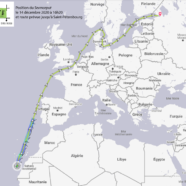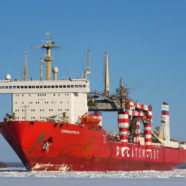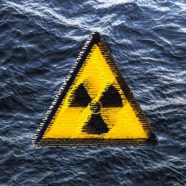A disabled atomic ship is heading towards Europe
Press release n°4
English version: December 15, 2020
The last of the nuclear-powered cargo ships, the Russian Sevmorput, is in breakdown (see previous press releases*). On her way to Antarctica to unload heavy loads for the extension of the Vostok research station, the Sevmorput was forced to turn back. Victim of propeller or propeller shaft damage, she returns to St. Petersburg at reduced speed after having been wandering round and round for several weeks off the coast of Angola and Congo Brazzaville. Angola and South Africa were reportedly opposed to the Sevmorput‘s entry into their ports to carry out repairs in a shipyard.
Last minute. Sevmorput in breakdown off the coast of Africa
 11:40 am – Press release n°3
11:40 am – Press release n°3
Robin des Bois wrote yesterday to Rosatom, owner of the Sevmorput. Thanks to Rosatom for his reply:
Sevmorput in breakdown off the coast of Africa
 November 20, 2020 – Press release n°2
November 20, 2020 – Press release n°2
The arrival of the Russian nuclear-powered cargo ship was scheduled for early November at Progress station, in the north of the Antarctic continent.
For more than a month, the Sevmorput has been suffering a failure. She has been sailing at reduced speed to and from a small square in the South Atlantic Ocean off Angola and Congo Brazzaville.
According the social network Vkontakte spread by the Barents Observer, the breakdown of the only civilian nuclear-powered merchant ship still in operation does not affect the reactor compartment. The technical problems would come from the propeller shaft. Divers would be at work to carry out repairs, which could only be precarious.
An atomic merchant ship is zigzagging towards Antarctica
9:45 a.m.
Her arrival was scheduled for early November in a Russian logistic station along the Emperor and Adelie penguins’ territory. Even today, the Sevmorput is coming and going off Angola and Congo-Brazzaville. For several days, her erratic movements have been reported by the newspaper Barents Observer. The trajectory of the Sevmorput continues to be atypical. She could be confronted with technical problems or diplomatic polemics.
The Antarctic Treaty prohibits the dumping of nuclear waste. The last and only official use of nuclear power in Antarctica dates back to the 1960s and 1970s when a 1.8 megawatt nuclear power plant supplied electricity to the U.S. McMurdo science station.
In search of a solution for the contaminated water of Fukushima
Earthquake and Tsunami in Japan, March 11, 2011 – Press release n°17
It is said that the Japanese government is about to authorize the release of radioactive water from Fukushima Daiichi into coastal waters and the ecosystem of the Pacific Ocean. Tepco, operator of the plant that crashed on March 11, 2011, the Ministry of Economy, Trade and Industry and the International Atomic Energy Agency are promoting this option. This voluntary pollution would set a precedent that could be brought up again in the Atlantic Ocean in the event of a major accident at a nuclear power plant or at the La Hague atomic complex in Normandy.
In search of a solution for the contaminated water of Fukushima
Earthquake and Tsunami in Japan, March 11, 2011 – Press release n°17
It is said that the Japanese government is about to authorize the release of radioactive water from Fukushima Daiichi into coastal waters and the ecosystem of the Pacific Ocean. Tepco, operator of the plant that crashed on March 11, 2011, the Ministry of Economy, Trade and Industry and the International Atomic Energy Agency are promoting this option. This voluntary pollution would set a precedent that could be brought up again in the Atlantic Ocean in the event of a major accident at a nuclear power plant or at the La Hague atomic complex in Normandy.
















